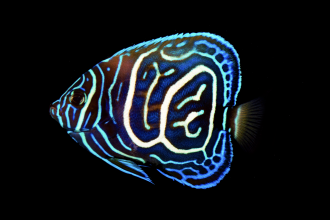Media release
From: The University of SydneyRenowned journal Proceedings of the Royal Society B has a new front cover fish: the marine angelfish. It commands star power due to a new study highlighting the remarkably high incidence of and tendency for hybridisation in this family (even between divergent species), more so than in any other group of coral reef fishes.
Hybridisation refers to the process by which two different species mate and produce hybrid offspring.
The research was led by Yi-Kai (Kai) Tea, PhD candidate at the University of Sydney’s School of Life and Environmental Sciences.
He and his colleagues, Professors Nathan Lo and Simon Ho, Dr Joseph DiBattista from the Australian Museum, Jean-Paul Hobbs from the University of Queensland, and Federico Vitelli from Edith Cowan University, sought to explore why only some fishes create hybrids, and the factors that facilitate this.
After deciding to focus on “one of the most charismatic and iconic groups of coral reef fishes”, the marine angelfish, they found that 42 species – nearly half of all known species of marine angelfishes – create hybrids.
“This is among the highest incidences of hybridisation in coral reef fishes,” Mr Tea said.
Near-opposites attract
“We also found that hybrids are frequently produced even between angelfish species that are distantly related to each other; some separated by over 10 million years in evolutionary time.”
Other hybrids were found between species with over 12 percent pairwise distance in mitochondrial DNA. Pairwise distance is a measurement of differences in pairs of DNA sequences.
“This genetic separation is quite astounding, considering that hybrids are rarely reported between species that share more than 2 percent in genetic distance,” Mr Tea said. “Though coral reef fish hybrids are common; they are usually formed by closely-related species.”
Boundless hybridisation
A third key finding was that angelfish hybridise wherever different species exist. This contrasts with other coral reef fishes, which tend to only hybridise within certain zones of their shared habitats.
“In terms of coral reef fish hybridisation, much remains unanswered, particularly in the context of why, and how hybrids are formed. We still don’t know why some species hybridise and others don’t. For example, the regal angelfish, Pygoplites diacanthus, is found throughout the Indian and Pacific Oceans, yet no hybrids have ever been reported for this species,” Mr Tea said.
“In terms of cracking the secrets to hybridisation in coral reefs, we’ve only just scratched the surface.”




